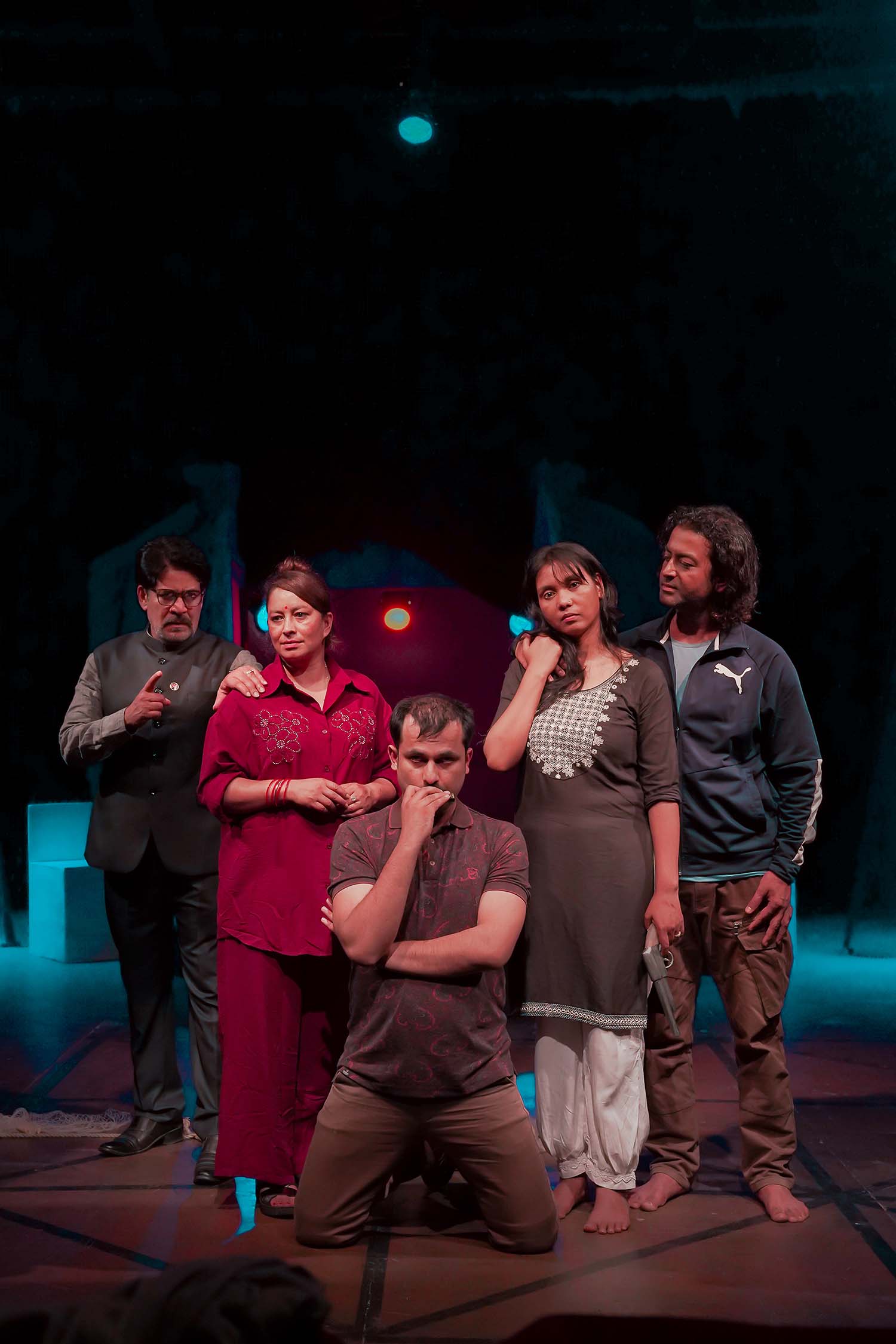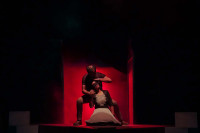Theater
Reckoning with truth, trauma, and silence
‘Manjira: The Muted Melody’, a Brechtian thriller confronting delayed justice and gendered violence in post-conflict Nepal, echoing the themes of Seamus Heaney’s ‘Punishment’.
Aarya Chand
The stage is dark. A man reaches out to embrace a woman. Still, just as their bodies seem to connect, she spins her hand away, first evading, then pointing a gun at his head. Her other hand gently strokes his cheek with tenderness, each repetition heightening the tension in a chilling theatricalisation of trauma’s recursive nature.
The mechanical repetition of the scene functions as a Brechtian device, creating a distancing effect in theatre that prompts the audience to critically engage with the emotional themes of ‘Manjira: The Muted Melody’. This production delves into the intricate relationships among justice, trauma, and power.
Directed by Som Nath Khanal, this Nepali adaptation of Ariel Dorfman's ‘Death and the Maiden’ transforms the original material into a distinctly South Asian context. Set in Bardia, where a family has relocated from Kathmandu, the play follows Prem (Sushank Mainali), the driver/Manjira’s husband, Manjira (Sarswoti Chaudhary), a domestic worker with a traumatised past, and the family she now lives with—a formal advocate and conflict victim activist, Gopal (Saroj Khanal), his wife Shanti (Sarita Giri).
The tranquil exterior is swiftly disrupted when Kabindra (Anup Neupane), a figure connected to the time during the insurgency, reappears. The encounter evolves into an overnight reckoning, a psychological trial where old wounds are reopened and unspoken truths are forced into the open.
At its core, ‘Manjira: The Muted Melody’ deals with the consequences of unacknowledged trauma, the fragility of truth, and the societal reluctance to confront violence committed under the guise of power. It explores the #MeToo movement’s resonance in Nepali society, questioning why women who come forward years after their assault are subjected to scrutiny while their perpetrators remain largely unaccountable.
By positioning a female survivor of state violence as the central voice and conscience of the narrative, the play critiques the silence and complicity of institutions, including the family, the state, and the legal system. The storyline reveals how democracy can become a tool of oppression when controlled by elites seeking power under the guise of public service.
Director Khanal utilises Brechtian devices—repetition, sudden shifts in language, and lighting that disturbs emotional immersion—to prevent passive consumption. These tools instead invite critical reflection. The result is not an emotional catharsis but a moral interrogation that unfolds both onstage and within the viewer.
Chaudhary delivers a tour-de-force performance as Manjira. Her ability to oscillate between vulnerability and menace in a single gesture—a trembling hand that can caress or kill—makes her character endlessly fascinating. Her use of the gun is symbolic, it represents the drastic measures women often need to take just to be heard.
Shanti, the wife and former lawyer played by Giri, emerges gradually as the moral compass of the narrative. Initially performing domestic chores and taking a backseat in family discussions, she gains prominence as she supports Manjira’s voice and challenges her husband’s reluctance to confront the truth. Her evolution throughout the play from passive participant to active advocate embodies the potential for allyship and agency recovery, particularly for women in patriarchal settings.
Kamal portrays a morally ambiguous figure who avoids accountability despite benefiting from oppressive systems, reflected in his dismissive attitude toward Manjira and his wife. He is soon offered a position as a commissioner in a high-level commission formed to investigate past crimes, something similar to a truth and reconciliation body. This opportunity reintroduces moral and political dilemmas into his life, forcing him to confront history and his personal silence and complicity.
Kabindra arrives at the household to congratulate Kamal on his prospective appointment. On the surface, his presence appears friendly as he joins Kamal in drinks and engages in light conversation. His composed demeanour and casual remarks introduce a subtle tension, suggesting unresolved layers to his character. Prem helps establish the emotionally fraught atmosphere that surrounds Manjira.
The performances throughout the cast are cohesive, each actor responding effectively to the play’s layered political and emotional textures. Director Khanal and choreographer Namrata KC create striking visual metaphors through their staging. The repeated push-pull of the opening scene becomes a physical manifestation of trauma's lingering effects.
The direction reflects precision and thoughtful pacing. While the dialogue is dense and idea-heavy, the flow of the play avoids stagnation. Scenes are allowed to breathe without dragging. The structural decision to reveal character motivations slowly, within a single night, adds to the believability and urgency.
Noteworthy is the recurring staging of spatial hierarchies. During a key interrogation scene, characters are positioned across levels on the stage: Kamal seated above on a dining table platform, his wife below him, and Kabindra at the lowest level; an effective visual metaphor for power, justice, and judgment.
Lighting is used strategically, contrasting to great effect, particularly in the interrogation scenes where shifting colours externalise psychological states.
Sound design by Mahendra Kumar Batha enhances the atmosphere significantly. The inclusion of thunder sounds created a sense of entrapment and psychological pressure. The cool temperature of the theatre, aligned with the onstage weather effects, contributed to a palpable atmosphere of unease; an immersive touch that aided the suspension of disbelief.

The use of the harmonica, tied to Manjira’s past, served as a haunting audio motif. Music and lyrics, written by Pinki Bohora and Anup Neupane, were embedded naturally into the narrative, adding poignancy without overwhelming the dialogue.
Costumes reflected socio-economic differences and cultural identities. Manjira’s attire, a kurtha and gagra reflecting Tharu heritage, contrasted with Sarita’s contemporary outfit and Saroj’s formal suit. The costume choices grounded the characters in specific contexts and reinforced class and cultural identities without appearing forced.
The play’s multilingualism—Nepali, Tharu, and English—is not merely decorative but integral to the play’s politics. Furthermore, the deliberate initial use of the Tharu language for crucial dialogues was a striking stylistic choice. It placed regional and indigenous identities at the centre.
Overall, it is not a comfortable play or meant to be. It provokes instead of pacifies. Its questions about justice, accountability, and silence resonate far beyond Nepal’s borders.
The production effectively uses Brechtian tools to challenge the audience rather than entertain. While some aspects of the trial are oversimplified, and certain investigative elements are compressed for narrative efficiency, these choices do not detract from the potency of its message.
Trigger warnings for scenes of torture and rape are given in the small leaflet due to the intense subject matter. It ultimately places women—both victim and advocate—at the centre of the narrative, offering a rare perspective on post-conflict reconciliation and remembrance.
This performance also brought to mind ‘Punishment’ by Seamus Heaney, in which the poet reflects on the brutal punishment of a woman for adultery during the Iron Age—a punishment that society justified while turning a blind eye to male transgressions. Heaney’s speaker watches silently, acknowledging his empathy and complicity in that silence.
Similarly, ‘Manjira: The Muted Melody’ exposes how women continue to be disbelieved, punished, or made to carry the burden of proof long after the violence has ended. The character of Manjira, much like the bog body in Heaney’s poem, becomes a figure through which larger social hypocrisies are laid bare. Both the poem and the play suggest that injustice persists through direct action and the collective silence of the onlookers, institutions, and history itself.
In the end, the play demands that we not simply feel for the characters, but ask ourselves what we do when faced with uncomfortable truths. Do we listen? Do we believe? Or do we, like so many before, turn away?
_____
Manjira: The Muted Melody
Director: Som Nath Khanal
Cast: Saroj Khanal, Sarita Giri, Sarswoti Chaudhary, Sushank Mainali and Anup Neupane
Duration: 1 hour 30 minutes
Venue: Mandala Theatre, Thapagaun
Showtimes: Every day at 5:15 pm except Monday and an extra 1:00 pm show on Saturday until June 22




 26.43°C Kathmandu
26.43°C Kathmandu














